|
|
|
GAUDAPADACHARYA or KAVALE MUTT
official website www.shrikavalemath.org.in
The Kavale
Mutt or Kaivalya Mutt is oldest of the Mutts of Saraswats and belongs to the Smarta tradition. After migration to Gomantak, due to
lack of communication facilities, the Saraswats settled in Goa lost contact with their
roots in saraswat desh. Being Brahmins, the Saraswats needed a spiritual leader. In 740
A.D, at the request of the Saraswats of Gomantak, Swami Vivarananda of the Gaudapada
tradition from Kashmir founded the Mutt at Kaushasthali and the whole Saraswat community
in Goa and Konkan became followers of this Mutt. This Mutt is named after Srimad Gaudapadacharya the first amongst the eminent Acharyas of
the Adwaita tradition, whose shishya Shri Govindapada gave deeksha to Adiguru Shri Shanakara
and Shri Vivarananda Saraswati who started the Guruparampara for GSBs.
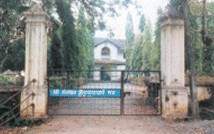 The original Gaudapadacharya
Mutt founded at Kushsthali, was destroyed during the Portuguese rule in Goa in 1564 AD.
The 57th guru Vidyananda Saraswathi and his two successors stayed at Golvan in Ratnagiri
and the 60th guru Ramananda Saraswati at Chindar. His successors Sadananda Saraswati and
Bhavananda Saraswati stayed and attained samadhi at Varanasi and never visited Goa. The
community members earlier approached Bhavananda Saraswati and pleaded with him to come
back to Goa. Bhavananda Swamy (the 62nd Guru) sent his disciple Sachchidananda swamy (the
63rd Guru) to revive the mutt in Goa. The Swamy stayed at Sonavade in Ratnagiri till the
time the Mutt at Kavalem was ready. The mutt headquarters was then shifted to Kaivalyapura (present Kavalem, Ponda district) in 1630 AD and presently known as Kavale
Mutt. The Mutt is in close proximity on the right side of Shree Shantadurga Temple,
Kavlem. The original Gaudapadacharya
Mutt founded at Kushsthali, was destroyed during the Portuguese rule in Goa in 1564 AD.
The 57th guru Vidyananda Saraswathi and his two successors stayed at Golvan in Ratnagiri
and the 60th guru Ramananda Saraswati at Chindar. His successors Sadananda Saraswati and
Bhavananda Saraswati stayed and attained samadhi at Varanasi and never visited Goa. The
community members earlier approached Bhavananda Saraswati and pleaded with him to come
back to Goa. Bhavananda Swamy (the 62nd Guru) sent his disciple Sachchidananda swamy (the
63rd Guru) to revive the mutt in Goa. The Swamy stayed at Sonavade in Ratnagiri till the
time the Mutt at Kavalem was ready. The mutt headquarters was then shifted to Kaivalyapura (present Kavalem, Ponda district) in 1630 AD and presently known as Kavale
Mutt. The Mutt is in close proximity on the right side of Shree Shantadurga Temple,
Kavlem.

Bhavani Shankar
|
The
present pontiff is Swami Sivanda Saraswati. He was initiated into sanyasa
in 1994 and became head of the mutt in 2005 after samadhi of his
guru Sri Sachidananda Saraswati.
The deity worshipped by the
Mutt is Bhavani Shankar. The Mutt is located at Kavlem,
Ponda, Goa.
|
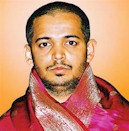
|
The mutt has its branches
at Kashi (Varanasi), Brahmavartha near Allahabad, Nasik, Walkeshwar (Bombay), Khanapur,
Sankhali (Goa), Sonavade, Chinder, Golvan, Sadashivgad, Halage (near Karwar), Gokarn,
Panaji and Belgaum. The mutt has followers in North Canara, Goa and Maharashtra. The mutt
has followers in North Canara, Goa and Maharashtra. Rajapur Saraswath Brahmins, who migrated from Goa to Balavali and
other villages in Rajapur Taluk of Ratnagiri district of Maharashtra state and
maintains a separate identity, also belong to this mutt. |
|
Top |
|
GOKARN PARTAGALI
JEEVOTTAM
MUTT
 The group of Saraswats
migrated along the sea shore were mainly Vaishnavas and acquired a reputation for trade
and agriculture. There were large settlements at Manglore and Bhatkal and smaller
settlements at other coastal towns. Ramachandra Tirtha of the Udupi Palimar mutt initiated
a Saraswat boy as sanyasi calling him as Narayana Tirtha in 1475. Sri Narayana Tirtha (a
Saraswat) of the Udupi Palimar Mutt during the 15th Century extensively conducted
propaganda in Goa, that many Saraswats in Sasashti region became Vaishnavas.
Though the Palimar Swamy, Ramachandra Tirtha wanted Narayana Tirtha to
succeed to his Mutt, it was not liked by the Tulu Vaishnava brahmins who were followers of
the Mutt. Hence a new Mutt for Vaishnava Saraswats alone was founded at Bhaktal in 1476
AD. This Mutt enjoyed the patronage of the Keladi rulers and the Vaishnava Saraswats of
Goa and most of those from undivided Canara were its followers. By fame and capacity
of the third Guru, Swami Jeevottam Tirtha, the Mutt came to be also known as Jeevottam
Mutt. His successor Purushottam Tirtha shifted to
Gokarn and the mutt was called Gokarn Jeevotham mutt. The group of Saraswats
migrated along the sea shore were mainly Vaishnavas and acquired a reputation for trade
and agriculture. There were large settlements at Manglore and Bhatkal and smaller
settlements at other coastal towns. Ramachandra Tirtha of the Udupi Palimar mutt initiated
a Saraswat boy as sanyasi calling him as Narayana Tirtha in 1475. Sri Narayana Tirtha (a
Saraswat) of the Udupi Palimar Mutt during the 15th Century extensively conducted
propaganda in Goa, that many Saraswats in Sasashti region became Vaishnavas.
Though the Palimar Swamy, Ramachandra Tirtha wanted Narayana Tirtha to
succeed to his Mutt, it was not liked by the Tulu Vaishnava brahmins who were followers of
the Mutt. Hence a new Mutt for Vaishnava Saraswats alone was founded at Bhaktal in 1476
AD. This Mutt enjoyed the patronage of the Keladi rulers and the Vaishnava Saraswats of
Goa and most of those from undivided Canara were its followers. By fame and capacity
of the third Guru, Swami Jeevottam Tirtha, the Mutt came to be also known as Jeevottam
Mutt. His successor Purushottam Tirtha shifted to
Gokarn and the mutt was called Gokarn Jeevotham mutt.
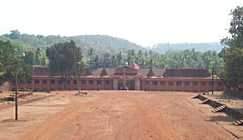 The Mutt headquarters was later (after the
samadhi of Swamy Shrikanta Tirtha) shifted to Partagali village on the banks of the sacred
river Kushavati in Goa and thus came to be known as Gokarn-Partagali
Mutt. Partagali is about 45 km from Margao. The nearest railhead is
Canacona Railway Station. The
Vaishnava Saraswats of Goa and most of those from undivided Kanara were its followers.
Vira Vithala is the deity worshipped by the Swamis of the Mutt. The
mutt has its establishments at Bhatkal, Gokarn, Basrur, Dicholi, Partagali,
Revona,
Mangalore, Ankola, Karvar, Varanasi, Wadala (Bombay), Vasco, Gangolli,
Venkatapur, Honavar, Yellapur, Badrinath and Siddapur. The Mutt headquarters was later (after the
samadhi of Swamy Shrikanta Tirtha) shifted to Partagali village on the banks of the sacred
river Kushavati in Goa and thus came to be known as Gokarn-Partagali
Mutt. Partagali is about 45 km from Margao. The nearest railhead is
Canacona Railway Station. The
Vaishnava Saraswats of Goa and most of those from undivided Kanara were its followers.
Vira Vithala is the deity worshipped by the Swamis of the Mutt. The
mutt has its establishments at Bhatkal, Gokarn, Basrur, Dicholi, Partagali,
Revona,
Mangalore, Ankola, Karvar, Varanasi, Wadala (Bombay), Vasco, Gangolli,
Venkatapur, Honavar, Yellapur, Badrinath and Siddapur.

Vira Vittala
|
The Gokarn-Pratagali
Mutt for Vaishnava saraswats has Vira Vittala as the worshipped deity.
Present pontiff Vidhyadhiraj Teertha succeeded to
the Peetha in 1973. Shri Swamiji was initiated into sanyas in Mumbai in Feb 26, 1967 by
his illustrious preceptor Shrimat Dwarkanath Thirtha Swamiji. The Mutt has its
headquarters at Partagali, Poinginim, Canacona, Goa 403702. |

|
The mutt is situated
in the sylvan surroundings of the Kushavati river and has many traditional
buildings including Vrindavan, Prayer halls and Visitor rooms. The Vata-Vriksha
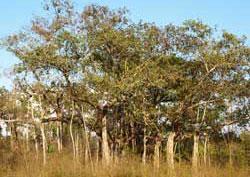 There is a giant Vata-vriksha
(Banyan tree) about 200 meters north of the Mutt with 220 aerial roots
covering an area of 235 x 225 feet and is believed to be over 1000 years old. It can
accommodate about 1000
people in its shade. The Vatavriksha and the Ishwar linga in front of the mutt are
worshiped by the people of Partagali.
The mutt, in 1977 instituted an award called Vidyadhiraj
Puraskar to be given away annually to a GSB of outstanding performance
in any field of human endeavor. The replica of the Vata-vriksha is
chosen as the momento for the award. There is a giant Vata-vriksha
(Banyan tree) about 200 meters north of the Mutt with 220 aerial roots
covering an area of 235 x 225 feet and is believed to be over 1000 years old. It can
accommodate about 1000
people in its shade. The Vatavriksha and the Ishwar linga in front of the mutt are
worshiped by the people of Partagali.
The mutt, in 1977 instituted an award called Vidyadhiraj
Puraskar to be given away annually to a GSB of outstanding performance
in any field of human endeavor. The replica of the Vata-vriksha is
chosen as the momento for the award.
|
|
Top |
|
KASHI MUTT
The History | Branches
| Vedavyas | Guruparampara

kashimath.org |
The GS Brahmins of Kerala and
South Karnataka are followers of the Shri Kashi Mutt Samsthan with headquarters at Shri
Kashi Math, 22/86 Brahma Ghat, Varanasi-221001 established in 1542 AD and branches
all over India.
Presiding Deities : Shri
Vyasa and Shri Raghupati popularly known as Shri Vyasa Raghupati.
The Present Guru : Shrimat
Sudhindra Tirtha Swamiji, 20th in the pontifical lineage. |
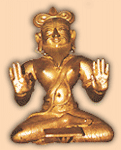
Vedavyas
|
Brief History
Shri Kashi Math, was founded in 1542 AD and the
first Swamiji Yadavendra Tirtha was given Deeksha by the
celebrated Shrimat Vijayindra Tirtha
Swamiji of Kumbhakonam Math.
The Gowda saraswats of kerala and south
karnataka were Vaishnavas and were followers of the Uttaradi mutt of
Jayatheerth. During the 15th century, Sri Ramachandra Tirtha of Uttaradi mutt
initiated Vibhudendra Tirtha
and Sri Vidhyanidhi Tirtha to sanyasa. The latter became head of
Uttaradi mutt and Sri Vibhudendra Tirtha founded a new Mutt at Kumbhakonam which
came to be known as Purvadi Mutt (later became Raghavendra
Swamy mutt, since great saint Raghavendra of Mantralaya fame belonged to this mutt). Gowda Saraswats of South Kanara and Kerala
were transferred to this Mutt.
When Surendra
Tirtha was head of the Mutt at Kumbhakonam, one of his disciples, Vijayindra Tirtha (who was a Saraswat Brahmin) was invited by Cochin Saraswats to
undertake Chaturmasya at Cochin in 1539–1540. They requested Him to initiate a Saraswat boy among them to Sanyasa. In
1541, Sri Hanumantha Bhaktha was selected and taken to Kumbakonam. The new Sanyasin was
named Yadavendra Tirtha who eventually became head of the new Kashi
Mutt at Varanasi established in 1542 AD. Shri
Kumbhakonam Math gave the idols of Lord Raghupati (Rama) and Vyasa
to Shrimat Yadavendra Tirtha along with the rights to guide the GSB Samaj in spiritual
matters.
A copper plate charter issued
by Surendra Tirtha on 21-1-1542 AD and received by Yadavendra Tirtha defines his
jurisdiction over the Saraswats.
We give an idol of Sri Rama,
a Vyasa idol, a salagrama, a pallak, a Sweta Chatra or white Umbrella, two chamarams, two peetas, two oil lamps, a white shanku, nagari or drum, phalakas and plates
to the Kashi mutt samsthan. We hereby permit to use the positions. You and your heirs
and successors while travelling across the country will have the rights to give
their seal (giving awards etc.) on to the Gowda Saraswat Brahmin community members. We will interfere to settle any infights that may occur in the Kashi mutt
samsthan. Those who do not follow this will be considered as
against Guru. Kashi mutt samsthan may have their own Guruparampara. We send this
undertaking in the name of Lord Narayana.
- KS Kamath, pp
57,Saraswata Kshetrangal, 1977 |
The gsb community of Cochin helped to buy
land at Benaras for the Mutt. The mutt building in Kashi is a big mansion with
about 110 rooms and in one of the pooja rooms, Shri Raghavendra Tirtha, the 5th
Swamiji had darshan of Lord Narasimha.
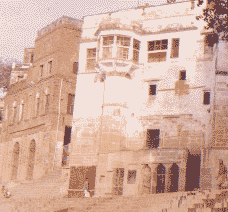
Mutt headquarters at Kashi
|
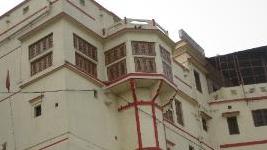
Mutt headquarters at Kashi (closer view) |
Guru Parampara : click for details
The following are the Swamijis of Shri Kashi Math Samsthan:
Their Holinesses, Shrimat
| 1. Yadavendra Tirtha |
8. Jnaneendra Tirtha |
15. Sumateendra Tirtha |
| 2. Keshavendra Tirtha |
9. Yadavendra Tirtha III |
16. Vasudendra Tirtha |
| 3. Upendra Tirtha |
10. Upendra Tirtha II |
17. Bhuvanendra Tirtha |
| 4. Yadavendra Tirtha |
11. Rajendra Tirtha |
18. Varadendra Tirtha |
| 5. Raghavendra Tirtha |
12. Surindra Tirtha |
19. Sukrateendra Tirtha |
| 6. Devendra Tirtha |
13. Vishnu Tirtha |
20. SUDHINDRA Tirtha |
| 7. Madhavendra Tirtha |
14. Vibhudendra Tirtha |
|
 The second Swamiji Shrimat Keshavendra
Tirtha while taking a bath in the holy River Ganga in Varanasi got another idol of Shri
Vyasa which today is the presiding deity of the math. The 7th Swamiji Shrimat Madhavendra
Tirth entered the samadhi when he was still alive in Walkeshwar, Mumbai in 1775 and every
Swamiji of the guruparampara has carved a name of his own among the saints of the GSB
Samaj. Shrimat Bhuvanendra Tirtha, 17th Swamiji and Shrimat Varadendra Tirtha, the 18th
Swamiji, were gifted Ayurvedic physicians. The second Swamiji Shrimat Keshavendra
Tirtha while taking a bath in the holy River Ganga in Varanasi got another idol of Shri
Vyasa which today is the presiding deity of the math. The 7th Swamiji Shrimat Madhavendra
Tirth entered the samadhi when he was still alive in Walkeshwar, Mumbai in 1775 and every
Swamiji of the guruparampara has carved a name of his own among the saints of the GSB
Samaj. Shrimat Bhuvanendra Tirtha, 17th Swamiji and Shrimat Varadendra Tirtha, the 18th
Swamiji, were gifted Ayurvedic physicians.
Internal strife (1834-1851)
Shrimat Vibhudendra Tirtha was the
fourteenth Swamiji of the Kashi Mutt Samsthan.The Swamiji had initiated a
boy into sanyasa and called him Shrimad Sumateendra Tirtha on 15 March 1815.
Later when the Guru Swamiji was camping in Manjeshwar in 1834, the Shishya
Swamiji was in Kochi. The Swamiji felt that his end was near and immediately
sent for his Shishya Swamiji. However, due to the non-availability of
suitable, rapid transport facilities, the Shishya-Swamiji could not come to
Manjeshwar in time. In order to ensure the continuity of the pujas of the
deities of the Kashi Matha Samsthan, the Guru-Swamiji initiated one Abaya
Bhat as next the Swamiji (named him Shrimat Vasudendra Tirtha) and attained Samadhi on 27 February 1834. His
Vridavana is in the Kashi Mutt premises in Manjeshwar.
Some time after the passing away of
Shrimat Vibhudendra Tirtha, a difference of opinion arose
between his two Shishya-Swamijis. It went to such an extent that the younger
Swamiji, Shrimad Vasudendra Tirtha demanded the division of all the movable
and immovable properties of the Kashi Mutt as well as the followers of
the Mutt and filed a suit in the Calicut court to that effect.
The two shishyas being the official and
legal heirs of the entire Kashi Mutt, the court agreed with the younger
Swamiji and issued the necessary decree for the division of the Mutt. But
before enforcing the different provisions of the decree two events happened,
which prevented changing the course of the history of Kashi Mutt.
-
-
Firstly, the elder Swamiji, Shrimat Sumateendra
Tirtha, selected a minor from his followers and initiated him into
sanyasa in 1849 and accepted him as shishya, who was named Shrimat
Bhuvanendra Tirtha
-
-
Secondly, the elder Swamiji, Shrimat Sumateendra
Tirtha, attained Samadhi on 31st January, 1851 in Shri Venkatapati
Temple, Alleppy, where his Vrindavana is situated. When this happened,
Shrimat Bhuvanendra Tirtha was still a minor.
In the meantime Shrimat Vasudendra Tirtha was camping in Shri Venkataramana
Temple, Kundapura. He was about to get the decree enforced, thereby dividing
the Mutt into two Mutts and also to select a Shishya. It was at this time
that news reached the Swamiji that his co-Shishya, Shrimad Sumateendra
Tirtha, attained Samadhi in Alleppey. His Shishya, being a minor, a question
arose as to who would be his guardian. The minor promptly and with great
foresight requested Shrimat Vasudendra Tirtha to be his guardian.
Now the latter obliged. Further, he gave
up the idea of division of the Kashi Mutt and even went a step further. He
voluntarily and with a broad mind delegated all his rights to his share of
the property of the Kashi Mutt sanctioned to him earlier by the court decree
mentioned earlier, to his ward, the minor Swamiji. He did not proceed with
his plans regarding the initiation of some one else into sanyasa and
accepting him as his shishya.
Shrimat Sudhindra Tirtha Swamiji
Shrimat
Sudhindra Tirtha Swamiji the present pontiff and 20th in the lineage of Shri Kashi Mutt
Samsthan was given sanyas deeksha by his preceptor, Sukrateendra Tirtha in Mulki on 24th May, 1944. |
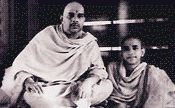
Sukrateendra Tirtha with young Sudhindra Tirtha
|
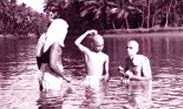
Sudhindra Tirtha being initiated to sanyasa at Mulki
|
Born on 31-3-1926 in Ernakulam, Kerala
(Poorvashram: Sadashiva Shenoy), he was an Intermediate science student when
selected. Shri Swamiji is a gifted orator and poet in Sanskrit. He has composed quite a
few stotras and prayers especially the Sree Vyasa Sahasranama.
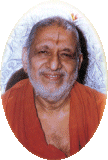 |
 |
|
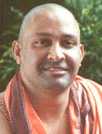 |
| Srimat Sudhindra Tirtha Swamiji |
Samyamindra Tirtha |
|
Raghavendra Tirtha |
Pattashishya (Up to
19th July, 2000) : Raghavendra Tirtha
Successor (from 20th June,
2002) : Samyameendra Tirtha
Internal strife (2000)
Sree Raghavendra Tirtha was appointed as the
successor to Sree Sudhindra Tirtha. But consequent to some unfortunate
incidents he was removed from the position on 19th July, 2000. Subsequently
another boy was initiated into sanyasa as Samyamindra Tirtha and accepted as Shisya on 20th
June, 2002 as the new successor. click
for pictures of the Shishya Sweekaran ceremony
The matter found its way to the law
courts. After prolonged judicial proceedings, the Fourth Additional District
Judge of Tirupathi, Sundara Ramaiah finally gave his verdict favouring the
senior swami. The court upheld the status of the senior swami as the ‘Matadhipathi’,
accepted the junior’s abdication and directed him to return all belongings
of the Math and refrain from interfering in its affairs. The items to be
returned include the Vyas Raghupathi idol which signifies authority of the ‘Matadhipathi’.
Subsequently Raghavendra Tirtha had challenged the judgment in the High
Court, where too he had lost. Sri Raghavendra Tirtha then
approached the Supreme court. The Supreme Court of India in 2010 rejected
the Special Leave Petition of Kashi Math Junior Swamiji Raghavendra Theertha
and upheld the High Court order recognizing Senior Swamiji Sudheendra Tirtha as the legitimate head of the Math.
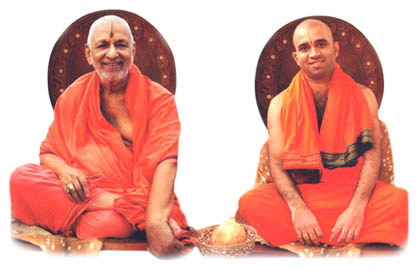
Srimat Sudhindra Tirtha & Samyamindra Tirtha
Shri Vyasa :
 According to Bhagawat Purana, Shri Vedavyasa is the
seventeenth incarnation of Lord Vishnu. He was born 5000 years ago as the son of Parashara
and Satyavati. Vedavyasa recompiled the sacred texts of the Vedas so that they might
become more easily understandable to men. It was thus that there came
to be four Vedas. Vedavyasa’s real name was Krishna Dvaipayana. He came to be known
as Vedavyasa because he divided the Vedas. These sacred texts
came to be known as Rig Veda, Yajur Veda, Sama Veda and Atharva Veda. Vedavyasa
taught the four Vedas to four of his disciples. Paila was taught the Rig Veda,
Vaishamapayana the Yajur Veda, Jaimini the Sama Veda and Sumanta the Atharva Veda.
The Puranas are known as the fifth Veda. Vedavyasa composed the Bhagavata Purana and
initially taught it to his son Shukadeva. Vedavyasa later taught the Puranas to his
disciple Romaharshana who was the father of Suta, the narrator of the Bhagavata Purana.
In addition to his works on the Vedas, he also composed the
Mahabharata, the longest epic ever seen by mankind. His hermitage (ashrama) was on the
banks of the river Saraswati. According to Bhagawat Purana, Shri Vedavyasa is the
seventeenth incarnation of Lord Vishnu. He was born 5000 years ago as the son of Parashara
and Satyavati. Vedavyasa recompiled the sacred texts of the Vedas so that they might
become more easily understandable to men. It was thus that there came
to be four Vedas. Vedavyasa’s real name was Krishna Dvaipayana. He came to be known
as Vedavyasa because he divided the Vedas. These sacred texts
came to be known as Rig Veda, Yajur Veda, Sama Veda and Atharva Veda. Vedavyasa
taught the four Vedas to four of his disciples. Paila was taught the Rig Veda,
Vaishamapayana the Yajur Veda, Jaimini the Sama Veda and Sumanta the Atharva Veda.
The Puranas are known as the fifth Veda. Vedavyasa composed the Bhagavata Purana and
initially taught it to his son Shukadeva. Vedavyasa later taught the Puranas to his
disciple Romaharshana who was the father of Suta, the narrator of the Bhagavata Purana.
In addition to his works on the Vedas, he also composed the
Mahabharata, the longest epic ever seen by mankind. His hermitage (ashrama) was on the
banks of the river Saraswati.
Guru Poornima is associated with Shri Vyasa who
is regarded as Adi Guru to all the sages, saints and sanyasis.
Shiva Purana mentions that
Lord Shiva had requested Lord Vishnu to assume Veda Vyasa avatar to preserve and propagate
the holy word that is Vedas. Shri Adi Shankaracharya worships him as Lord Vishnu while
Shri Madhwacharya giving his mantra states that by worshipping Shri Vyasa alone one will
get all round knowledge.
Shri Sudhindra Tirtha Swamiji felt that for
Bhagwan Shri Vedavyasa, the greatest author the mankind has ever seen, did not have a
befitting monument at the national level. Mobilising the support of the disciples in the
span of 10 years he erected a great and magnificent temple in Haridwar at the Vedavyasa
Ashram, which is a marvel in the arena of temple architecture and is considered as one of
the tourist and pilgrims' attraction in Haridwar.
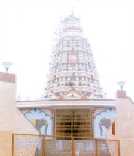
|
Vedavyas in mothers lap
A similar temple has been erected in Kalpi
near Kanpur in Uttarpradesh, the birth place of Shri Vyasa. He was born in an
island in the River Yamuna near Kalpi. The temple was consecrated by Shri Swamiji on
29th June, 2001.
The Kalpi Vyasa temple |
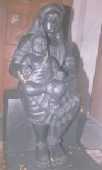
|
Branches of the Math : (click for address)
Dakshina Kannada and Udupi Districts: Basrur,
Bantwal, Hangarkatta, Hemmady, Karkal, Konchady, Kota, Naravi, Nayampalli, Shirva and
Suratkal.
Other Places in Karnataka: Bangalore, Basrur, Bhagmandal and
Bhatkal.
Kerala State: Ambalamedu, Calicut, Manjeshwar and Palliport.
Rest of India: Bandora (Goa), Chennai, Haridwar, Kalpi, Khed,
Mumbai-Walkeshwar, Nashik, Prayag (Allahabad), Tirumalai (Tirupati)
The Kashi Mutt is also running schools to
foster Sanskrit learning and train purohits at Karkal and Basrur.
Among all the branches of the math, the
following two need a special mention :
Shri Walkeshwar Kashi Math (Bombay) :
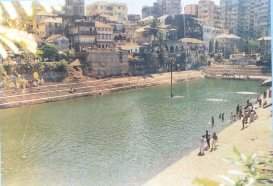
Banaganga tank
|
Banaganga and
Walkeshwar area in Bombay is an ancient home of Gowda Saraswat Brahmins. Sage Gautam
had his hermitage here. Lord Rama came here with his brother, Lakshman in search of Sita. When he was thirsty, as there was no water readily available, he shot an arrow and
brought Ganga over here. Hence Bana (arrow in Sanskrit) Ganga. The water is available in a
pond. Sage Gautam advised Lord Rama to worship Lord Shiva to get back his wife. Lord Rama
then made a shivling from the sand (Valuka in Sanskrit) and so the word Walkeshwar. |
The first Walkeshwar Temple was constructed in
1127 AD by a GSB minister, Lakshman Prabhu, in the court of Shilahar Kings in Thane. It
was reconstructed by the then famous Rama Kamat in 1715 AD.
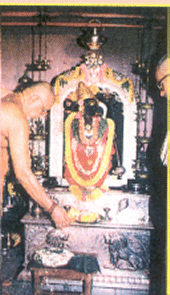 On the western bank of the tank
there is a Branch of the Shri Kashi Math, a famous religious seat of Gowda
Saraswats. There are two samadhis in the Math Premises. On the western bank of the tank
there is a Branch of the Shri Kashi Math, a famous religious seat of Gowda
Saraswats. There are two samadhis in the Math Premises.
1.Shri Madhavendra Tirth(7th Swamiji,
Samadhi year 1775). It is believed that Shri Swamiji is still alive in the state of
samadhi to grace the disciples.
2. Shri Varadendra Tirth (18th
Swamiji: Samadhi year 1914)
The Math holds annual Saptah Mahotsav for
7 days (uninterrupted bhajans) starting from Nag Panchami in the month of Shravan since
1927 AD.
Shri Vyasa ashram,
Haridwar :
(Address: Haripur Marg, Sadhu Bela, Haridwar-249 410, UP
)
More than an Ashram, it is a great temple close
to Saptarshi Ashram, on the outskirts of Haridwar.
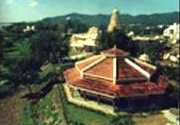
An aerial view of Vyasa ashram
Haridwar
|
Erected as a
monument to Shri Vyasa, this acts as a model temple combining religious activities with
welfare activities. Consecrated on 26th Feb. 1988 by the Swamiji himself, the temple has
Shri Vyasa as the presiding deity with his son, Shuka Muni, and disciples, Paila,
Vaishampayan, Jaimini and Sumantu. |

Swamiji offering Ganga Arati
at Haridwar
|
There are life-size idols of the mythological
Saptarshis and also the trimurtis, Brahma Vishnu and Maheshwara. Interestingly, the
traditional dwarapals or the guards are not the Jaya Vijaya here, but the characters in
the Upanishads, the famous students, Nachiketa and Satyakama. Shri Swamiji has taken
personal care to bring in many facets of Puranas and Mahabharat as a tribute to the great
Vyasa who authored those immortal books.
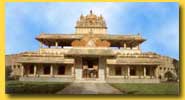 In activities, this temple resembles an ancient ashram. Standing on the
banks of the River Ganga, it has a big garden that gives flowers and fruits for the poojas
and a bathing ghat to take holy dips in the river. There is a small shrine dedicated to
Mother Ganga on the ghat itself to offer prayers soon after the bath. A gow-shala with 30
to 40 cows supplies milk, again for pooja. Viewing from another angle, it has a big
auditorium for assemblies, a dining hall with free food for guests and inmates and a
perpetual annadan arrangement for anyone who visits during lunchtime. There is a health
care centre to cater to the needs of the locality which otherwise did not have any.
Staying accommodation is available in the temple complex with good amenities on a modest
rent. In activities, this temple resembles an ancient ashram. Standing on the
banks of the River Ganga, it has a big garden that gives flowers and fruits for the poojas
and a bathing ghat to take holy dips in the river. There is a small shrine dedicated to
Mother Ganga on the ghat itself to offer prayers soon after the bath. A gow-shala with 30
to 40 cows supplies milk, again for pooja. Viewing from another angle, it has a big
auditorium for assemblies, a dining hall with free food for guests and inmates and a
perpetual annadan arrangement for anyone who visits during lunchtime. There is a health
care centre to cater to the needs of the locality which otherwise did not have any.
Staying accommodation is available in the temple complex with good amenities on a modest
rent.
The temple celebrates its annual foundation day
on Phalguna Shukla Navami (mostly in the month of February) every year. The temple
indirectly depicts the glorious heights that the GSB community has attained and deserves a
visit by everyone. |
|
Top |
|
CHITRAPUR MUTT
official website
www.chitrapurmath.net
 The group of
Smarta Gowda Saraswats (mainly Kushasthalikar and Keloshikar families) who migrated to
Karnatak at the time of the Muslim invasion in the 1400’s were mostly the educators
and administrators. This migrant group moved a little inland to North and South Kanara.
Some of them secured prominent positions as accountants in the courts of the Hindu rulers
of the time. One such Hindu king of the Keladi kingdom, was so impressed by the diligence
and skills of his Saraswat accountant, that he decreed that each village in his kingdom,
be administered by a Saraswat. Eventually these Saraswats took on the name of the village
as their last name. Once they had migrated to the Kanara district, the Shenvis were not
able to sustain their unity with the Saraswat Brahmins they had left behind in Goa.
Eventhough they continued to believe in Smarta tradition, their connection with the Kavale
mutt was cutoff since the Kavale mutt at Kushathali was destroyed in 1564 AD and Swamijis
shifted to Varanasi and were not available locally. The group of
Smarta Gowda Saraswats (mainly Kushasthalikar and Keloshikar families) who migrated to
Karnatak at the time of the Muslim invasion in the 1400’s were mostly the educators
and administrators. This migrant group moved a little inland to North and South Kanara.
Some of them secured prominent positions as accountants in the courts of the Hindu rulers
of the time. One such Hindu king of the Keladi kingdom, was so impressed by the diligence
and skills of his Saraswat accountant, that he decreed that each village in his kingdom,
be administered by a Saraswat. Eventually these Saraswats took on the name of the village
as their last name. Once they had migrated to the Kanara district, the Shenvis were not
able to sustain their unity with the Saraswat Brahmins they had left behind in Goa.
Eventhough they continued to believe in Smarta tradition, their connection with the Kavale
mutt was cutoff since the Kavale mutt at Kushathali was destroyed in 1564 AD and Swamijis
shifted to Varanasi and were not available locally.
This group considered themselves superior in
intellect and cutoff connection with other groups in Goa claiming that they are direct
decendents of Kashmiri saraswats and eventually formed their own sub-sect, called the Chitrapur Saraswat Brahmins (also referred as Bhanaps) and continued their Smarta tradition.
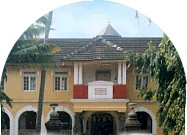 Although the Saraswats were well respected, they were
not readily recognized as true Brahmins by the local Brahmins, accusing that the Saraswats
have no spiritual guru in reality. The King issued a decree stating
that unless the community showed their guru, they will be outcast. The Shenvis felt that it was necessary
to seek a spiritual preceptor for their community. They
pleaded with a Saraswat Sanyasi, Parijananasharma Swamy, visiting from North India, to
become their Guru. He consented to guide the community and established a new Mutt for them
in Gokarn in 1708 AD. The Chief of royal court, however, still had his prejudices and
would not be satisfied unless he had a personal interview with the Swamiji and the
Jagatguru Shankaracharya of Shringeri accepted Him as a Swamiji of the Community. Swamiji,
therefore travelled from Gokarn to Nagar and the Chief was satisfied with Swamiji who
thereafter proceeded to Shringeri. There the Jagatguru was so much pleased with
his
learning, piety and yoga that he readily acknowledged Him as religious head. His regime
lasted till 1720. His samadhi is in Bhandikeri, Gokarn. Although the Saraswats were well respected, they were
not readily recognized as true Brahmins by the local Brahmins, accusing that the Saraswats
have no spiritual guru in reality. The King issued a decree stating
that unless the community showed their guru, they will be outcast. The Shenvis felt that it was necessary
to seek a spiritual preceptor for their community. They
pleaded with a Saraswat Sanyasi, Parijananasharma Swamy, visiting from North India, to
become their Guru. He consented to guide the community and established a new Mutt for them
in Gokarn in 1708 AD. The Chief of royal court, however, still had his prejudices and
would not be satisfied unless he had a personal interview with the Swamiji and the
Jagatguru Shankaracharya of Shringeri accepted Him as a Swamiji of the Community. Swamiji,
therefore travelled from Gokarn to Nagar and the Chief was satisfied with Swamiji who
thereafter proceeded to Shringeri. There the Jagatguru was so much pleased with
his
learning, piety and yoga that he readily acknowledged Him as religious head. His regime
lasted till 1720. His samadhi is in Bhandikeri, Gokarn.
Shri Shankarashram Swami was ordained by Shri
Parijnanashram Swami in 1720 AD as the second guru. In 1739 AD, the ruler Basavappa Nayaka
II donated land in Gokarn to build a mutt in reverence to their primary deity, Shri
Bhavanishankar. Shri Shankarasharm Swamy when in his advanced age, was on his way from
Udupi to Gokarn and while in Chitrapur, at the residence of Nagarkattikars an ardent
devotee, he fell seriously ill and attained Samadhi in 1757 AD. When the question of
location of His Samadhi came up, the Nagarkattikars readily offered their house for the
Samadhi and a temple. A mutt was erected there at Chitrapur near Shirali in Uttara Kannada
and soon it became headquarters of the Mutt.
The last Swamiji Parijnanashram-III attained Samadhi in Bangalore in
1991 without appointing a successor. On February 27, 1997 Swami Sadyojat Samvit Giri was
ordained as the reigning Guru of Chitrapur mutt and was named Shrimat Sadyojat
Shankarashrama. The coronation ceremony was attended and blessed by H.H. Jagadguru
Shankaracharya.
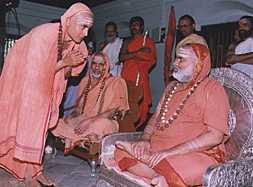
Coronation ceremony 1997
|
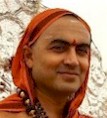
present pontiff
Shrimat Sadyojat Shankarashrama
|
The worshipped deity of the Chitrapur
Mutt is Bhavani Shankar and follow the Smarta tradition.
When the British ruled India, the Bhanaps took
to English education earlier than others. Subsequently, they were able to obtain key jobs
at the district offices and the Collector’s offices in Mangalore, Honavar and Karwar
and also were employed as administrators in Cotton and Textile export industry in Kumta,
Hubli and Dharwad.
The number of Chitrapur Saraswats is about 25,000 according to 2001 census.
|

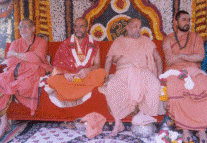







 There is a giant Vata-vriksha
(Banyan tree) about 200 meters north of the Mutt with 220 aerial roots
covering an area of 235 x 225 feet and is believed to be over 1000 years old. It can
accommodate about 1000
people in its shade. The Vatavriksha and the Ishwar linga in front of the mutt are
worshiped by the people of Partagali.
There is a giant Vata-vriksha
(Banyan tree) about 200 meters north of the Mutt with 220 aerial roots
covering an area of 235 x 225 feet and is believed to be over 1000 years old. It can
accommodate about 1000
people in its shade. The Vatavriksha and the Ishwar linga in front of the mutt are
worshiped by the people of Partagali. 













